Slanting birch
+4
my nellie
MrFancyPlants
Kevin S - Wisco Bonsai
Vlad
8 posters
Page 1 of 1
 Slanting birch
Slanting birch
Betula verrucosa
Height: 45 cm
Width: 60 cm
Pot: Michal Sebor
The third of my medium to large birch trees.
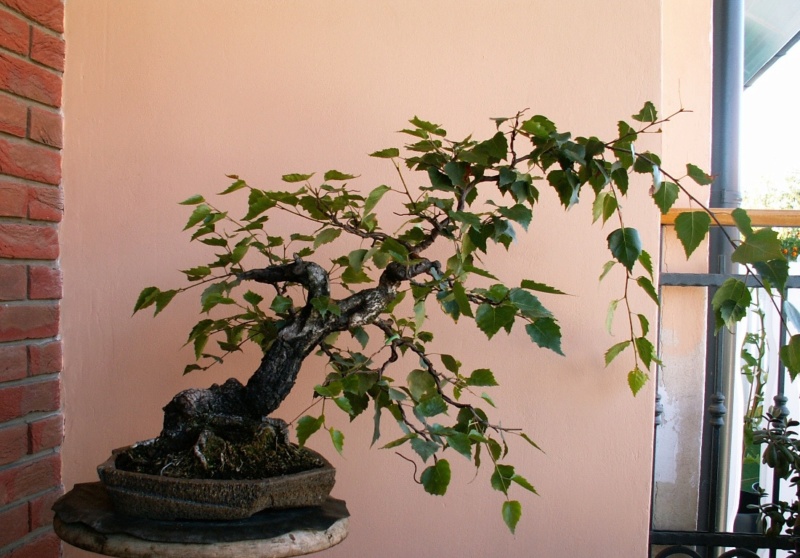
I need to get the top section of the trunk a bit more thicker. In my experience you need a lot of patience as the birches are a bit bitchy producing just long whips with minimum impact on the girth.
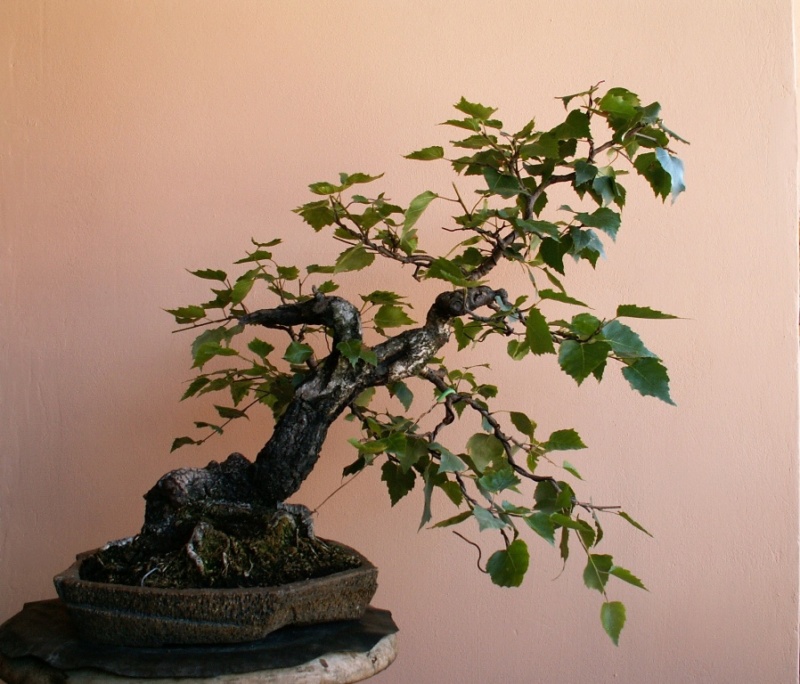
Lower part of the trunk with a burl ( the molehill on the right side of the shari )

Leaves far too big. Planned deoliation should help a bit. Apart it will improve the winter look.
No wheeping branches this time.
Height: 45 cm
Width: 60 cm
Pot: Michal Sebor
The third of my medium to large birch trees.

I need to get the top section of the trunk a bit more thicker. In my experience you need a lot of patience as the birches are a bit bitchy producing just long whips with minimum impact on the girth.

Lower part of the trunk with a burl ( the molehill on the right side of the shari )

Leaves far too big. Planned deoliation should help a bit. Apart it will improve the winter look.
No wheeping branches this time.
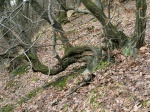
Vlad- Member
 Re: Slanting birch
Re: Slanting birch
this one is great Vlad !!!
(and who made the vessel ???)
(and who made the vessel ???)

Kevin S - Wisco Bonsai- Member
 Re: Slanting birch
Re: Slanting birch
Thank you, Kevin.
Pot: a gift from my friend Michal Sebor who spent +5 hours to form it based on the pics I have sent him after visiting well known blog The top rim is not the way it should be but otherwise I do like it. I hope I will manage to convince him to produce some more for some of my trees.
The top rim is not the way it should be but otherwise I do like it. I hope I will manage to convince him to produce some more for some of my trees.
Pot: a gift from my friend Michal Sebor who spent +5 hours to form it based on the pics I have sent him after visiting well known blog

Vlad- Member
 Re: Slanting birch
Re: Slanting birch
Wow, good stuff. Love the whole thing, but that bark in particular. Makes me want to see your whole garden; you've been posting remarkable tree after remarkable tree. Was this one collected?

MrFancyPlants- Member
 Re: Slanting birch
Re: Slanting birch
Vlad wrote:it is a tree from nearby grove.
I see sooooo much great material coming out of Eastern Europe...

Kevin S - Wisco Bonsai- Member
 Re: Slanting birch
Re: Slanting birch
I LOVE slanting form!
And this one is really very special!
Thank you for sharing Vladimir!
And this one is really very special!
Thank you for sharing Vladimir!

my nellie- Member
 Re: Slanting birch
Re: Slanting birch
Thank you, Alexandra. It is interesting how the trees in Nature deal with the forces of gravitation. Sometimes there are massive or buttress roots that anchor the tree from the top, sometimes they are located on the other side. Either way, I find it very dramatic.
I agree Kevin. There are great hornbeams, plums and some other species from Croatia. But what about olives from South, junipers/pines from Alps/Pyrenees, yews/blackthorns from UK, junipers/pines from US?
I agree Kevin. There are great hornbeams, plums and some other species from Croatia. But what about olives from South, junipers/pines from Alps/Pyrenees, yews/blackthorns from UK, junipers/pines from US?

Vlad- Member
 Re: Slanting birch
Re: Slanting birch
I do agree about the Junies and Pines from the mountainous regions of the US...
I wish I lived closer to such areas...
I wish I lived closer to such areas...

Kevin S - Wisco Bonsai- Member
 Re: Slanting birch
Re: Slanting birch
Yet another cracking tree Vlad!
Well on the way. Nice pot as well.
Regards
Richard
Well on the way. Nice pot as well.
Regards
Richard

Richard S- Member
 Re: Slanting birch
Re: Slanting birch
Thank you, Richard. The pot is too shallow for a thirsty birch but I was eager to use it and did not find any better fit. Need to move the birch to something with more depth next season.

Vlad- Member
 Re: Slanting birch
Re: Slanting birch
Such great looking birch. Mine is also "waterholic" specialy in shell pot. Might change location or give little bigger pot. Keep up great work Vlad.

yamasuri- Member
 Re: Slanting birch
Re: Slanting birch
Amazing little Silver Birch!
The bark has tons of character! This has made me even more excited to collect my local Paper Birches (Betula Papyrifera) this spring!
After reading about how efficiently your birches move water, I'm going to rethink my substrate mix for them. I have access to lots of living sphagnum moss and haircap moss. Colin Lewis wrote a bit about how he uses living sphagnum as an organic component. I've also seen a few people recover sick/weak trees by growing them in pure live sphagnum. He also wrote about how sphagnum prevents root rot by creating an acidic environment unsuitable for bacteria to grow. I wonder how birches would respond to this environment? They tend to grow together with the mosses in the wild, so I don't think the acidity is much of a problem. I could be wrong though.
For reference, here is the article I was talking about: Soils 1: Organics The part about moss is near the bottom. "In conclusion, it appears that any organic matter available commercially is of little use, but home-made or wild gathered matter can provide ideal organic ingredients for bonsai soils.". He makes some interesting points and its a good read.
I'm interested to see more of your birches Vlad. Also, have you had any luck with Aspen? I hear a lot about how the tree will die back almost at random but I'm skeptical. I have a hunch that they benefit from the mycorrhizal fungi in their native soil. My reasoning is that I find a species of Leccinum called the "Aspen Bolete" growing almost exclusively with the Aspen. They are a mycorrhizal fungi that require the tree to survive. Maybe there's something to that.
A Leccinum I found growing under an Aspen tree along with Mossberry (Empetrum Nigrum).
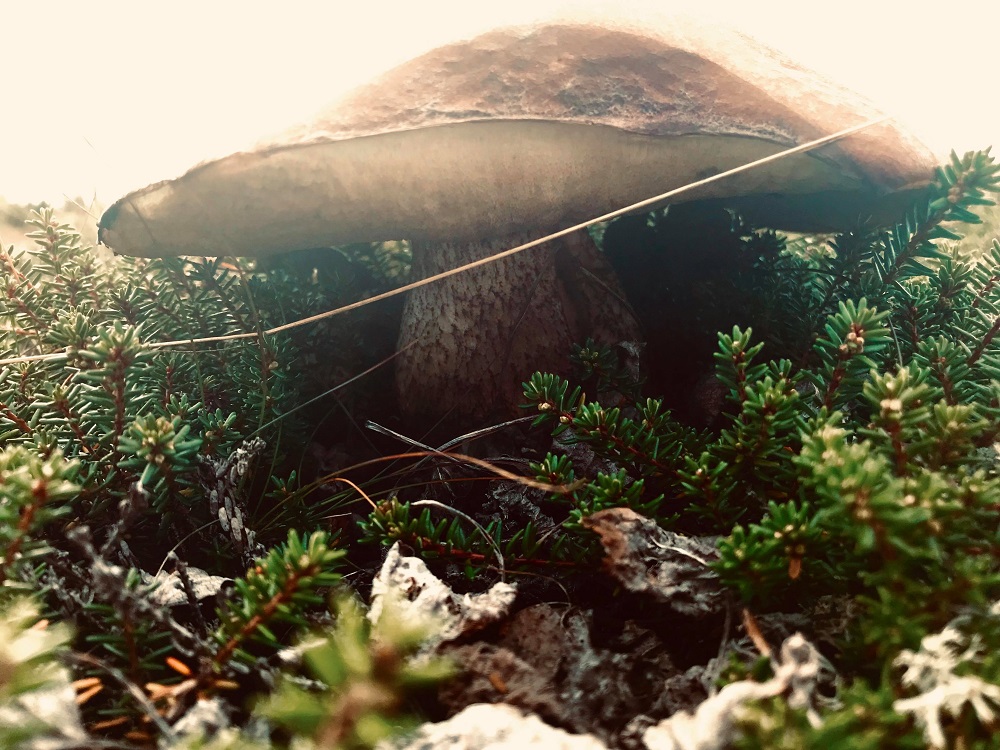
The bark has tons of character! This has made me even more excited to collect my local Paper Birches (Betula Papyrifera) this spring!
After reading about how efficiently your birches move water, I'm going to rethink my substrate mix for them. I have access to lots of living sphagnum moss and haircap moss. Colin Lewis wrote a bit about how he uses living sphagnum as an organic component. I've also seen a few people recover sick/weak trees by growing them in pure live sphagnum. He also wrote about how sphagnum prevents root rot by creating an acidic environment unsuitable for bacteria to grow. I wonder how birches would respond to this environment? They tend to grow together with the mosses in the wild, so I don't think the acidity is much of a problem. I could be wrong though.
For reference, here is the article I was talking about: Soils 1: Organics The part about moss is near the bottom. "In conclusion, it appears that any organic matter available commercially is of little use, but home-made or wild gathered matter can provide ideal organic ingredients for bonsai soils.". He makes some interesting points and its a good read.
I'm interested to see more of your birches Vlad. Also, have you had any luck with Aspen? I hear a lot about how the tree will die back almost at random but I'm skeptical. I have a hunch that they benefit from the mycorrhizal fungi in their native soil. My reasoning is that I find a species of Leccinum called the "Aspen Bolete" growing almost exclusively with the Aspen. They are a mycorrhizal fungi that require the tree to survive. Maybe there's something to that.
A Leccinum I found growing under an Aspen tree along with Mossberry (Empetrum Nigrum).

Last edited by JPH on Mon Mar 07, 2022 10:59 pm; edited 3 times in total (Reason for editing : Grammar. Added info. Removed a redundant photo.)
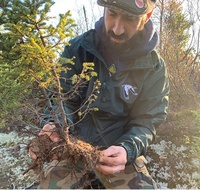
JPH- Member
Vlad likes this post
 Re: Slanting birch
Re: Slanting birch
Birches are great. if you go for it please remember that they are kind of a pioneer plants. ( Well, at least in my region. ) They are first ones to grow on forest clearings, slags heaps etc. At the same time they are also quick in "making" decision such as: this branch is weak. No problem to drop it and start a new one. With a proper horticulture they are very responsive though. Well, that is my experience with B. berrucosa.
B. papyrifera v. verrucosa there seems to be a significant visual difference looking at the base of the tree. B.v. develops blackish deeply cracked bark with some age. Not sure if the same is true for B.p.? I guess there are some other visual differences and the same may apply for their soil, acidity, humidity etc requirements. You seems to have a good eyes to see and understand what the plants needs.
I do not grow any aspen.
B. papyrifera v. verrucosa there seems to be a significant visual difference looking at the base of the tree. B.v. develops blackish deeply cracked bark with some age. Not sure if the same is true for B.p.? I guess there are some other visual differences and the same may apply for their soil, acidity, humidity etc requirements. You seems to have a good eyes to see and understand what the plants needs.
I do not grow any aspen.

Vlad- Member
JPH likes this post
 Re: Slanting birch
Re: Slanting birch
The Paper Birches in my area are definitely a pioneer species.
The way you describe their behavior makes a lot of sense to me. And I'll be sure to keep in mind the trees quick "decision" making skills. Thank you Vlad. I'll keep you posted about birches I collect and their progress. It would be interesting to see how our two varieties compare in terms of behavior. I suspect they are very similar though.
If I'm interpreting this correctly, it would seem Birches need special attention to how you direct their energy. With so much water moving through the tissue of the plant, I'm willing to bet they don't like being messed with in the spring/early summer. And as a pioneer species, I'd wager making sure every branch has sufficient exposure to light is paramount since the tree sheds branches to conserve and redirect energy. Interesting! I'm even more excited.
As for the character of the bark, B.p. will mostly develop a bright white, paper-like bark. As it matures the bark can have the consistency of unworked leather! This is why the tree is used for building canoes and other implements by the original people of the area. The flaky sections of the bark are used as fire-starter as it is full of oils and catches fire very easily. I have seen a few "older" examples in the wild where the base of the tree had developed dark, cracked bark. But generally they keep their paper-white appearance.
Not a bonsai question... But do people tap the birch trees where you live? None of them are big enough in my area, but if you head further south people tap them and boil down the sap into a syrup. Similar to Sugar Maples (Acer Saccharum).
The way you describe their behavior makes a lot of sense to me. And I'll be sure to keep in mind the trees quick "decision" making skills. Thank you Vlad. I'll keep you posted about birches I collect and their progress. It would be interesting to see how our two varieties compare in terms of behavior. I suspect they are very similar though.
If I'm interpreting this correctly, it would seem Birches need special attention to how you direct their energy. With so much water moving through the tissue of the plant, I'm willing to bet they don't like being messed with in the spring/early summer. And as a pioneer species, I'd wager making sure every branch has sufficient exposure to light is paramount since the tree sheds branches to conserve and redirect energy. Interesting! I'm even more excited.
As for the character of the bark, B.p. will mostly develop a bright white, paper-like bark. As it matures the bark can have the consistency of unworked leather! This is why the tree is used for building canoes and other implements by the original people of the area. The flaky sections of the bark are used as fire-starter as it is full of oils and catches fire very easily. I have seen a few "older" examples in the wild where the base of the tree had developed dark, cracked bark. But generally they keep their paper-white appearance.
Not a bonsai question... But do people tap the birch trees where you live? None of them are big enough in my area, but if you head further south people tap them and boil down the sap into a syrup. Similar to Sugar Maples (Acer Saccharum).

JPH- Member
 Re: Slanting birch
Re: Slanting birch
There seems to be quite few superstitions related to birches as a bonsai. Dropping branches, no or only slow whitening of the bark in a pot, no wire left on a tree during the winter, wheeping branches prone to the dieback etc.
Please find some points that I tend to follow. For sure it is just a way how I deal with birches - no attempt to say it is the only way to folow. It would be great if the others share their views...
Wiring and light pruning - in autumn trying to fix it well before the first heavier frosts. Also trying to avoid any heavy bending of the wired branches as this could damage the tissue calling for a problem
I do leave the wire on the tree over the winter and spring ( checking for the biting ) Please note the temps in winter will go under -20 C only exceptionally.
In spring I do leave the tree to do his job as you rightly pointed out. The bleeding sap is sweety and attracts problems.
Heavier pruning- after the first flush of growth leaving small stubs to avoid dieback. It can be completely reduced once dry.
Defoliation - no problem with my birches - again after the first flush of growth
Sap. It is great and refreshing. I like to make a cup of tea or coffe from it. You can buy it in a shop but it is not cheep... Tapping is not allowed in CZ, you have to get permission from the owner which is fair...
Looking forward for your updates.
Please find some points that I tend to follow. For sure it is just a way how I deal with birches - no attempt to say it is the only way to folow. It would be great if the others share their views...
Wiring and light pruning - in autumn trying to fix it well before the first heavier frosts. Also trying to avoid any heavy bending of the wired branches as this could damage the tissue calling for a problem
I do leave the wire on the tree over the winter and spring ( checking for the biting ) Please note the temps in winter will go under -20 C only exceptionally.
In spring I do leave the tree to do his job as you rightly pointed out. The bleeding sap is sweety and attracts problems.
Heavier pruning- after the first flush of growth leaving small stubs to avoid dieback. It can be completely reduced once dry.
Defoliation - no problem with my birches - again after the first flush of growth
Sap. It is great and refreshing. I like to make a cup of tea or coffe from it. You can buy it in a shop but it is not cheep... Tapping is not allowed in CZ, you have to get permission from the owner which is fair...
Looking forward for your updates.

Vlad- Member
Thomas Urban likes this post
 Re: Slanting birch
Re: Slanting birch
Vlad, I really like your pot, reminds me of Jonathan Cross 
Anyway, while I don't have a Birch myself anymore, I find your info to be pretty spot on and I'd approach them the same way. Especially with the heaviest work being after the first spring flush has hardened off as the tree is in energy positive.
There's also a podcast where I think Dennis vojtilla talked about how you don't want to let them grow out much like we normally do with deciduous or conifers. As in create sacrifice growth the ramp up the tree, he says if you avoid this as well and clip before a branch reaches 4 or more buds, the tree will for the most part keep it instead of completely discarding the branch. So it seems patience is the best way to approach this "fast growing" species that many of our bonsai kin relate to as hard or impossible trees because they "die off".
Birch sap! Never thought about it and the idea seems yummy.
Anyway, while I don't have a Birch myself anymore, I find your info to be pretty spot on and I'd approach them the same way. Especially with the heaviest work being after the first spring flush has hardened off as the tree is in energy positive.
There's also a podcast where I think Dennis vojtilla talked about how you don't want to let them grow out much like we normally do with deciduous or conifers. As in create sacrifice growth the ramp up the tree, he says if you avoid this as well and clip before a branch reaches 4 or more buds, the tree will for the most part keep it instead of completely discarding the branch. So it seems patience is the best way to approach this "fast growing" species that many of our bonsai kin relate to as hard or impossible trees because they "die off".
Birch sap! Never thought about it and the idea seems yummy.
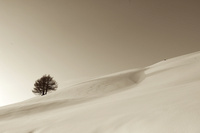
Thomas Urban- Member
 Re: Slanting birch
Re: Slanting birch
The pot is a result of a good number of hours my friend Michal Sebor spent on it. The shape of it has been inspired by the early works of Jonathan for sure.
Thank you for your heads up regarding pruning. I think that even a sacrifice branch can work on a birch. But once we take the cutter we should remove the sac. branch in few steps spanned over the season. Well again, this works for me and it has not been tested on a good number of trees.
PATIENCE should be the first important skill we learn in bonsai I believe.
And frankly one of the most difficult to learn:)
Thank you for your heads up regarding pruning. I think that even a sacrifice branch can work on a birch. But once we take the cutter we should remove the sac. branch in few steps spanned over the season. Well again, this works for me and it has not been tested on a good number of trees.
PATIENCE should be the first important skill we learn in bonsai I believe.
And frankly one of the most difficult to learn:)

Vlad- Member
Thomas Urban likes this post
 Similar topics
Similar topics» Pemphis slanting.....
» Cotoneaster Slanting Progression
» Slanting Picea question
» Slanting Copper Beech
» Streblus asper - Slanting
» Cotoneaster Slanting Progression
» Slanting Picea question
» Slanting Copper Beech
» Streblus asper - Slanting
Page 1 of 1
Permissions in this forum:
You cannot reply to topics in this forum









